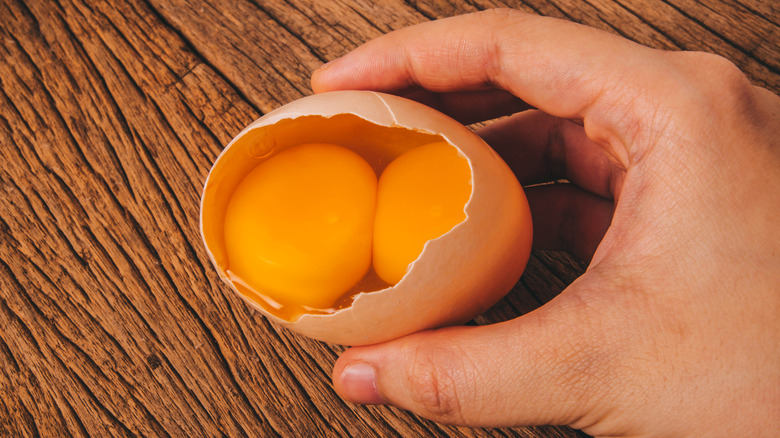The Egg Superstition That Foreshadowed Death In Norse Mythology
You really can't beat eggs when it comes to nutrition. Per HuffPost, people have been eating eggs since prehistoric times, and over the millennia, different cultures have developed numerous myths and legends regarding eggs and their role in the world. These myths are as diverse as the cultures that created them, often touching on major themes like birth, life, and death.
Some cultures even had myths regarding particular types of eggs, or more accurately, egg abnormalities. For instance, Norse mythology ascribed a very specific meaning to eggs with double yolks, a curious phenomenon that only occurs in 1 out of 1,000 eggs per Nellie's Free Range.
Purina offers greater insight into how hens actually formulate and lay eggs, with a new egg being produced every 24 to 26 hours. It all begins with the release of the yolk, which enters the oviduct or reproductive tract. From there, the yolk is surrounded in layers of protective tissue that make up the interior egg white and outer shell. Once the process is complete, the hen lays the egg and soon after releases a new yolk. Like most biological processes, there is room for occasional errors when it comes to egg-laying.
Why some hens lay eggs with two yolks
In the realm of egg oddities, double egg yolks seem relatively tame by comparison. Yellow Birch Hobby Farm describes a few abnormal offerings, such as strange shapes, soft shells, bizarre growths, and other surprises. For instance, one egg can sometimes form inside another if it suddenly reverses course during the laying process. Egg shells can also appear mottled or wrinkly, which indicates they were repaired in the hen's oviduct after being damaged.
As for double yolks, Australia's ABC explains double yolks result from a dysfunction when releasing the yolk. In this case, the hen will release two yolks in succession, instead of waiting the normal amount of time to release the subsequent yolk. As both yolks travel through the reproductive tract, they're surrounded by egg white and shell just like a single yolk would be. The result is an egg that appears normal from the outside, but that harbors a surprise inside. And while many consider this surprise to be a lucky occurrence, not all cultures share the same positive perspective.
Egg-based myths exist in many cultures
As illustrated by Egg Farmers of Canada, eggs have played a frequent role in the mythology of numerous cultures. In Ancient Egypt, the sun god Ra was said to have originated from a giant celestial egg. Ancient Greece had a similar myth describing the birth of Phanes, a god that served as the progenitor for all other gods in the Greek pantheon. Eggs were also used for fertility rituals in numerous Western countries, including Germany and France.
Per Chickens and More, the Romani people even held a fertility myth that related directly to double-yolk eggs. In this case, seeing two yolks within the egg means that any currently pregnant family members will be giving birth to twins.
However, double yolks are not always an indicator of life and good fortune. The decidedly more downbeat Norse mythology thought that double-yolk eggs are actually a harbinger of impending death. It remains a mystery as to how something as wholesome as double the protein could prove threatening, but such is the nature of mythology and its attempts to understand the physical world.


